Building for Refugees
New Concepts for Living
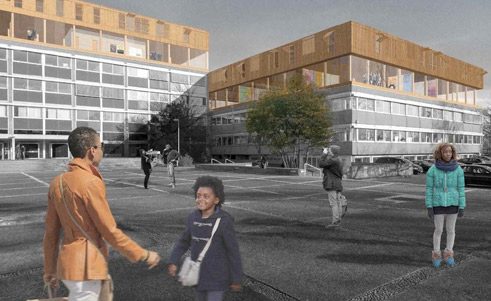
German authorities are faced with the object of providing suitable accommodation for refugees. Ideas and concepts show how appropriate housing for sustainable use can be created quickly.
In the year 2015, over a million people from all crisis regions of this world had reached Germany as refugees. People seeking protection and in need of a place to stay, whether temporarily or permanently. Germany has opened its borders to all refugees. The motto of chancellor Angela Merkel: “We can do it!” set in motion a new wave of willingness to help.
But it is also becoming increasingly clear that managing this task represents a greatsocietal challenge and requires community energies. The Bundesländer have long since been coordinating their efforts and have requested so called administrative assistance from the municipalities in providing care and shelter for refugees. Vacant barracks, schools, hotels, DIY supermarkets as well as on a temporary basis gymnasiums, and trade fair and industrial halls have been repurposed as emergency shelters. Tent camps, containers and winterised quick-assembly cabins have been set up to offer at least basic shelter. But this still cannot be described as housing.
“Refugees welcome”
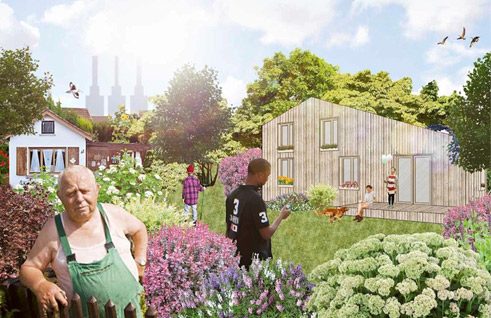 Collage for housing in garden plot;
| Photo: Jovis Verlag
Collage for housing in garden plot;
| Photo: Jovis Verlag
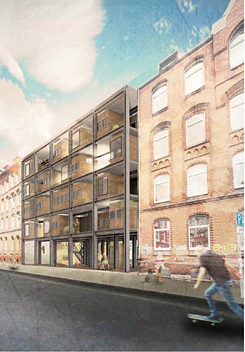 Collage for closing gaps;
| Photo: Jovis Verlag
At the federal and state level, easing of construction law requirements to facilitate planning has been hurriedly obtained to make available pre-existing shelters and facilitate the building of new ones. Parallel to the federal government, the states and municipalities, and of relief, social and church organisations, voluntary fire-fighters and numerous private initiatives, Germany’s architects are also championing the cause: Architectural associations and chambers are combining their energies and offering solutions for issues relating to shelter and housing. Already in spring 2015, a step forward was taken by Hamburg architect Jörg Friedrich, who teaches as a Professor of Design and Architectural Theory at the University of Hanover. Together with his students, he developed a series of new housing concepts, with Hanover serving as illustration. These concepts were presented in the publication Refugees Welcome (Jovis Verlag).
Collage for closing gaps;
| Photo: Jovis Verlag
At the federal and state level, easing of construction law requirements to facilitate planning has been hurriedly obtained to make available pre-existing shelters and facilitate the building of new ones. Parallel to the federal government, the states and municipalities, and of relief, social and church organisations, voluntary fire-fighters and numerous private initiatives, Germany’s architects are also championing the cause: Architectural associations and chambers are combining their energies and offering solutions for issues relating to shelter and housing. Already in spring 2015, a step forward was taken by Hamburg architect Jörg Friedrich, who teaches as a Professor of Design and Architectural Theory at the University of Hanover. Together with his students, he developed a series of new housing concepts, with Hanover serving as illustration. These concepts were presented in the publication Refugees Welcome (Jovis Verlag).Among their concepts is construction on locations for which zoning plans exist, but no land-use plans, courtyard conversions, flat-roof buildings of modular wood construction, floating housing units on old barges, or converting allotment cabins. The central issue here is to explore spatial and social potentials in cities. Jörg Friedrich wants that planners and developers consider differentiated, mixed approaches in architectural and urban-planning implementation instead of hasty improvisation. So out of the initial use as refugee housing, housing for students and others can be developed later on.
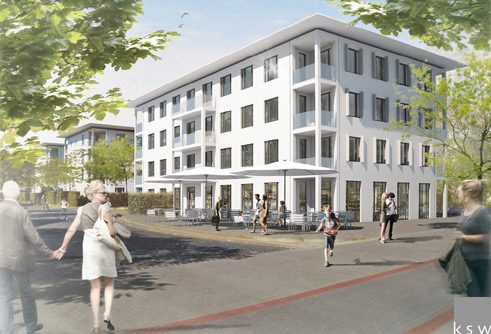 Closing the gap in Kopernikusstrasse in Hanover;
| Renderung: KSW Architekten
The architectural firm ksw architekten + stadtplaner has developed a sustainable mixed approach in a housing project as gap closure for the urban housing association Bauen und Wohnen in the Kopernikusstrasse in Hanover. The refugee housing units above a storefront level are conceived in such a way that out of four units per storey six can be adapted later on. The conversion was taken into consideration already when the plannig begun, so interventions are reduced to a minimum.
Closing the gap in Kopernikusstrasse in Hanover;
| Renderung: KSW Architekten
The architectural firm ksw architekten + stadtplaner has developed a sustainable mixed approach in a housing project as gap closure for the urban housing association Bauen und Wohnen in the Kopernikusstrasse in Hanover. The refugee housing units above a storefront level are conceived in such a way that out of four units per storey six can be adapted later on. The conversion was taken into consideration already when the plannig begun, so interventions are reduced to a minimum.
Modular construction
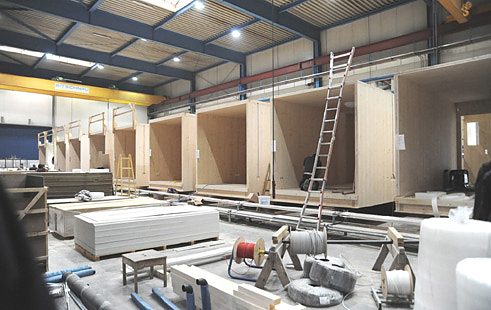 Modular construction in Vorarlberg;
| Photo: Mosaik Architekten
Timber-construction residential complexes, so called “modular locations”, are being planned for Hanover’s Linden-Nord district with an eye to longer-term use. The three two-storey housing rows for about 100 refugees consist of montages of approx. 2.70 x 12 meter containers. These wooden modules are produced, complete with all interior features, in the state of Vorarlberg, Austria. Three to five containers are assembled into a single housing unit with a community kitchen. The upper-storey flats are accessed via an arcade that serves as an emergency exit at the same time. The project, collaboratively developed by the city’s building management with Mosaik Architekten BDA, Drewes + Speth and the firm LINNEA Landschaftsarchitektur, is designed in such a way that subsequent use by student flat shares or families is conceivable.
Modular construction in Vorarlberg;
| Photo: Mosaik Architekten
Timber-construction residential complexes, so called “modular locations”, are being planned for Hanover’s Linden-Nord district with an eye to longer-term use. The three two-storey housing rows for about 100 refugees consist of montages of approx. 2.70 x 12 meter containers. These wooden modules are produced, complete with all interior features, in the state of Vorarlberg, Austria. Three to five containers are assembled into a single housing unit with a community kitchen. The upper-storey flats are accessed via an arcade that serves as an emergency exit at the same time. The project, collaboratively developed by the city’s building management with Mosaik Architekten BDA, Drewes + Speth and the firm LINNEA Landschaftsarchitektur, is designed in such a way that subsequent use by student flat shares or families is conceivable.
Living and working
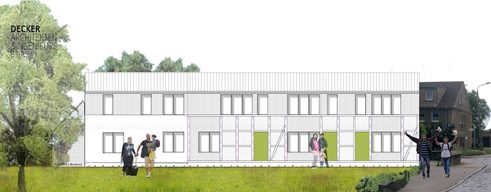 Housing in Hötzum;
| Photo: Decker Architekten
Private initiatives, such as that of Roland Bohlmann of Hötzum, a village in the southeast of the German State Lower Saxony. He is planning to convert an old building in the countryside, in collaboration with Braunschweig architect Lieselotte Decker. Here, not only long-established village residents are helping out, but also numerous businesses from the region are supporting the project with construction materials. In this project, living and working are closely linked. Four refugee families will not only live here in the future. They will have their own work areas in two adjoining workshops, since skilled craftspeople are needed in depopulated this rural area.
Housing in Hötzum;
| Photo: Decker Architekten
Private initiatives, such as that of Roland Bohlmann of Hötzum, a village in the southeast of the German State Lower Saxony. He is planning to convert an old building in the countryside, in collaboration with Braunschweig architect Lieselotte Decker. Here, not only long-established village residents are helping out, but also numerous businesses from the region are supporting the project with construction materials. In this project, living and working are closely linked. Four refugee families will not only live here in the future. They will have their own work areas in two adjoining workshops, since skilled craftspeople are needed in depopulated this rural area.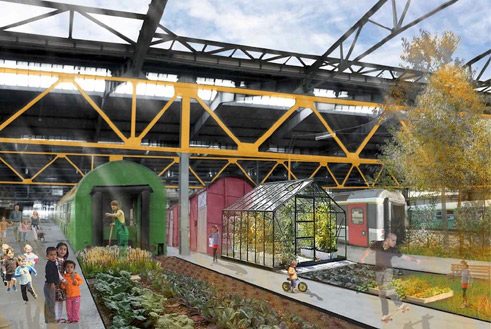 Collage for housing at trains station;
| Photo: Jovis Verlag
That refugees should live in completely normal housing is also the view of Berlin architect and Professor of Architecture and Urban Resaerch, Arno Brandlhuber. Germany’s almost two million vacant flats and houses can be used for the new arrivals. He makes the case for building a wide range of housing types, above all budget-friendly ones. Brandlhuber advocates venturing more experiments in housing construction, and believes that existing standards for materials and housing typologies should be given a second look and re-evaluated. Doing so would open up a great opportunity for letting architecture and the city live out the full spectrum of their diversity and possibilities.
Collage for housing at trains station;
| Photo: Jovis Verlag
That refugees should live in completely normal housing is also the view of Berlin architect and Professor of Architecture and Urban Resaerch, Arno Brandlhuber. Germany’s almost two million vacant flats and houses can be used for the new arrivals. He makes the case for building a wide range of housing types, above all budget-friendly ones. Brandlhuber advocates venturing more experiments in housing construction, and believes that existing standards for materials and housing typologies should be given a second look and re-evaluated. Doing so would open up a great opportunity for letting architecture and the city live out the full spectrum of their diversity and possibilities.